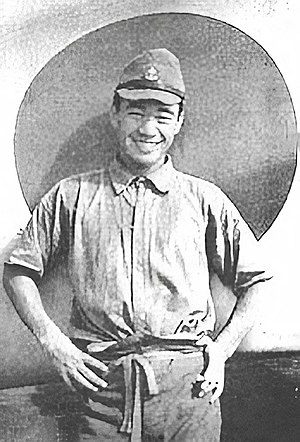Saburō Sakai

Sub-Lieutenant Saburō Sakai (坂井 三郎, Sakai Saburō, 25 August 1916 – 22 September 2000) was a Japanese naval aviator and flying ace (“Gekitsui-O”, 撃墜王) of the Imperial Japanese Navy during World War II. Sakai had 28-64 aerial victories (including shared) by official Japanese records,[1] while his autobiography Samurai!, co-written by Martin Caidin and Fred Saito, claims 64 aerial victories.[2] Such discrepancies are common, and pilots’ official scores are often lower than those claimed by the pilots themselves, due to difficulties in providing appropriate witnesses or verifying wreckage, and variations in military reports due to loss or destruction.
Saburō Sakai was born on 25 August 1916 in Saga in Japan. Sakai was born into a family with immediate affiliation to samurai and their warrior legacies and whose ancestors (themselves samurai) had taken part in the Japanese invasions of Korea between 1592 to 1598, but who were later forced to take up a livelihood of farming following haihan-chiken in 1871.[3] He is the third-born of four sons (his given name literally means “third son”), and had three sisters. Sakai was 11 when his father died, leaving his mother alone to raise seven children. With limited resources, Sakai was adopted by his maternal uncle, who financed his education in a Tokyo high school. However, Sakai failed to do well in his studies and was sent back to Saga after his second year.
On 31 May 1933 at the age of 16, Sakai enlisted in the Japanese Navy as a Sailor Fourth Class (Seaman Recruit) (四等水兵). Sakai described his experiences as a naval recruit:
Sakai posing in front of the hinomaru on his Mitsubishi A5M Type 96 fighter (Wuhan, 1939).
“The petty officers would not hesitate to administer the severest beatings to recruits they felt deserving of punishment. Whenever I committed a breach of discipline or an error in training, I was dragged physically from my cot by a petty officer. ‘Stand tall to the wall! Bend down, Recruit Sakai!’ he would roar. ‘I am not doing this because I hate you, but because I like you and want you to make a good seaman. Bend down!’ And with that he would swing a large stick of wood and with every ounce of strength he possessed would slam it against my upturned bottom. The pain was terrible, the force of the blows unremitting.”[4]
After completing his training the following year, Sakai graduated as a Sailor Third Class (Ordinary Seaman) (三等水兵). He then served aboard the battleship Kirishima for one year. In 1935, he successfully passed the competitive examinations for the Naval Gunners’ School. Sakai was promoted to Sailor Second Class (Able Seaman) (二等水兵) in 1936, and served on the battleship Haruna as a turret gunner. He received successive promotions to Sailor First Class (Leading Seaman) (一等水兵) and to Petty Officer Third Class (三等兵曹). In early 1937, he applied for and was accepted into the navy pilot training program. He graduated first in his class at Tsuchiura in 1937 and earned a silver watch, presented to him by Emperor Hirohito himself. Sakai graduated as a carrier pilot, although he was never assigned to aircraft-carrier duty. One of Sakai’s classmates was Jūzō Mori, who graduated as a carrier pilot and served on the Japanese aircraft carrier Sōryū flying Nakajima B5N torpedo bombers early in the war. [5]
Promoted to Petty Officer Second Class (二等兵曹) in 1938, Sakai took part in aerial combat flying the Mitsubishi A5M at the beginning of the Second Sino-Japanese War in 1938–1939 and was wounded in action. Later, Sakai was selected to fly the Mitsubishi A6M2 Zero fighter in combat over China.
